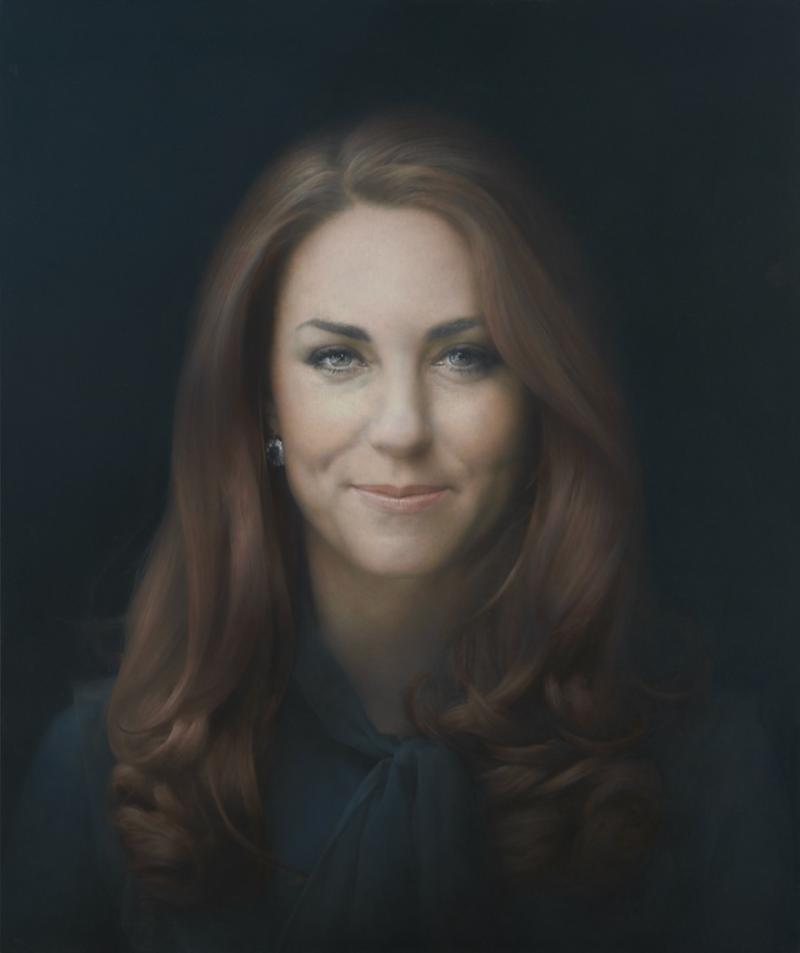


The first thing to say about Paul Elmsley’s portrait of the Duchess of Cambridge, which was unveiled yesterday at the National Portrait Gallery, is that it looks rather better in real life than it does in reproduction. That doesn’t make it a great painting, but nor is it a risible one.
Certainly, there’s a liveliness around the eyes and mouth that isn’t conveyed in a reproduction, with the reproduction’s flattening effect. And in fact, it’s those eyes that draw you to the portrait, animating Kate’s features and echoing the sapphire and diamond earring that is the only piece of jewellery visible (her late mother-in-law’s, worn during the announcement of Diana and Charles’s engagement) in what is otherwise a very plain, unfussy portrait. And it’s a good physical likeness. More than that, with her slightly guarded smile coupled with her arrestingly direct gaze, it captures both a sense of the sitter’s warmth and openness as well as a certain girlish diffidence.
Kate looks stiff and rather straitjacketed in that big-bowed blouse that comes up to her throat
But let’s not get carried away. This is a terribly conventional portrait. And it’s a disappointing portrait. If it had been a head portrait rather than a looking-straight-ahead, quarter-length one, the painting might have been more enlivened by those quietly animated features. Instead, Kate looks stiff and rather straitjacketed in that big-bowed blouse that comes up to her throat.
But here’s the real problem. We do not live in the age of royal portraiture. Its role, like that of the Royal Family [3], is not as clear-cut as it once was and is substantially diminished as a result. Just as the nation has not yet fully adjusted to a relationship that balances deference and familiarity on one side, and intimacy and aloofness on the other, neither has the royal portrait [4].
Moreover, how does the artist portray a member of a traditional institution in a visual idiom that has its roots in the early Renaissance [5]? Royal portraiture is today as much of an anachronism as the role of the Poet Laureate. Do poets use the language of Dryden to pronounce upon the splendiferous majesty of Her Majesty? How does the poet write verse in celebration of a royal event that doesn't appear absurd? Ask Andrew Motion. On second thoughts, better not. It’s an impossible task and Elmsley hasn’t done a bad job under the circumstances. He’s certainly done a better one than Lucian Freud [6] did with the Queen [7].
But, like Kate as she appears in her first official portrait, any artist commissioned to paint a royal likeness will be straitjacketed, by convention, by tradition and by duty. What a thankless task for the artist.
Links
[1] https://theartsdesk.com/users/fisunguner
[2] https://www.addtoany.com/share_save
[3] http://www.theartsdesk.com/topics/royalty
[4] http://www.theartsdesk.com/tv/painting-queen-portrait-her-majesty-bbc-four
[5] http://www.theartsdesk.com/topics/renaissance
[6] http://www.theartsdesk.com/visual-arts/lucian-freud-portraits-national-portrait-gallery
[7] http://www.theartsdesk.com/visual-arts/queen-art-and-image-national-portrait-gallery
[8] http://www.npg.org.uk/shop/shop-list.php?showProductDetails=5991
[9] https://twitter.com/FisunGuner
[10] https://theartsdesk.com/node/53033/view
[11] https://theartsdesk.com/node/27748/view
[12] https://theartsdesk.com/node/27745/view
[13] https://theartsdesk.com/node/765/view
[14] https://theartsdesk.com/node/36899/view
[15] https://theartsdesk.com/visual-arts
[16] https://theartsdesk.com/topics/portraits
[17] https://theartsdesk.com/topics/reviews
[18] https://theartsdesk.com/topics/national-portrait-gallery